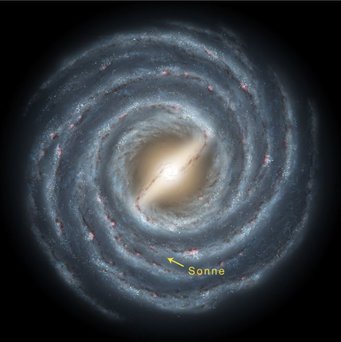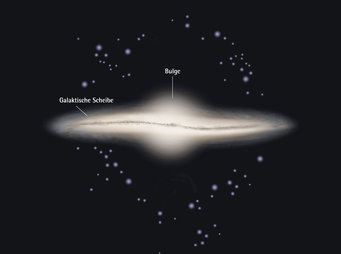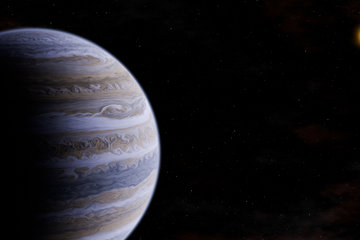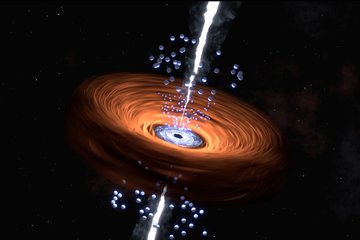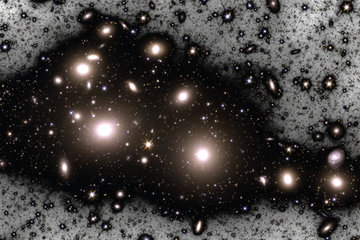The backbone of the night
Like a huge spiral, the Milky Way floats in space
For thousands of years, people have been puzzling over the milky strip that extends across the entire firmament. In the modern era, Galileo Galilei discovered that this Milky Way consists of countless stars. However, it was not until the 20th century that astronomers succeeded in deciphering its form and its true nature.
Text: Helmut Hornung

“My third observation relates to the nature of the Milky Way (...) No matter which part of it one targets with the telescope, one finds a huge number of stars, several of which are quite large and very striking; yet, the number of small stars is absolutely unfathomable.” These words were written in 1610 by a man who with his self-constructed telescope studied unknown lands that were not of this world. It was this work that earned him a place in history: Galileo Galilei.
The land that he described is literally out of this world, and the document bears the title Sidereus Nuncius (“Starry Messenger”). In it, the Italian mathematician and astronomer presents his observations of the satellites of Jupiter, the Earth’s moon and also the Milky Way. Until then, their nature had remained a mystery, and had above all been the subject of mythology. The Greek natural philosopher Democritus had already claimed in the 5th century BC that the diffusely glowing strip in the sky – known by the African !Kung bushmen as the “backbone of the night” – consisted of countless weak stars.
Grindstone in the firmament

After the discovery made by Galilei, however, nearly 150 years would pass before this celestial structure would again became the subject of scientific study. Thomas Wright of County Durham believed that stars were arranged in a flat region similar to a grindstone, which extended over the entire sky. For him, the Milky Way was nothing other than the projection of this grindstone. The German philosopher Immanuel Kant seized on this theory – and came very close to discovering the truth.
In his General Natural History and Theory of the Heavens, published in 1755, he explained the Milky Way as an extended and very diluted layer of stars. The Sun, the Earth and all the other planets were part of this layer - but not at its centre. Depending on the line of sight, along the plane of the layer or vertically out of it, we would see different numbers of stars.
But how were the astronomers to find out whether the apparent view of the Milky Way in the sky reflected its actual spatial structure? Stellar statistics devised at the end of the 18th century by Friedrich Wilhelm Herschel promised a solution: Herschel recorded the coordinates and brightness of all the stars that he could see through his telescope.
However, the undertaking failed: apart from the unreliability of these measurements – for example, although it was possible to determine the apparent brightness of the stars, it was impossible to determine their absolute luminosity and hence their distance – there was also a fundamental problem: the Milky Way is filled with interstellar matter, gas and dust clouds that absorb the light from the stars. This obscures the view of the central region and makes it impossible to see the overarching structure. For this reason, stellar statistics can never encompass the system as a whole, but only the region around the Sun up to a radius of about 10,000 light-years. The breakthrough did not come until the middle of the 20th century, when astronomers learned to look at the sky with different eyes using radio telescopes.
A look through curtains of dust

Hydrogen is the most common element in the universe. As part of interstellar matter, neutral hydrogen (H1) fills the space between the stars, and thus also fills the Milky Way. This means that the distribution of clouds of hydrogen gas trace the shape of the whole system, similar to the way in which bones shape the human body.
But how can these cosmic “bones” be made visible? The answer is provided by the nanouniverse: in the ground state of hydrogen, the direction of spin of the atomic nucleus and the electron that orbits around it are antiparallel. If two hydrogen atoms collide, the direction of spin of the nucleus and the electron may be flipped to end up parallel to each other – and after a certain time, they return to their basic antiparallel state.
This process releases energy, which is radiated as an electromagnetic wave. This line lies in the radio range of the electromagnetic spectrum. Despite the extremely low density of interstellar matter, atoms are constantly colliding, causing the H 1 areas to glow in the light of this hydrogen line.
This radiation penetrates the dust curtains almost unobstructed and can be picked up by radio telescopes. Thanks to this new window into the universe, astronomers have been able to discover the spiral structure of the Milky Way. However, in the 1970s, researchers found that hydrogen alone was not sufficient as an indicator of the galaxy’s morphology because, for example, it is less concentrated in the spiral arms than expected. The search began anew.
Arms in motion
The most important indicator turned out to be clouds of interstellar molecules; they emit radiation in the light of carbon monoxide (CO). Now it was gradually becoming possible to refine the portrait of the Milky Way. Accordingly, the galaxy (from the Greek word gala: milk) is a bent wheel, 100,000 light years in diameter and with a thickness of just 5,000 light years. The wheel hub with its black hole is surrounded by a spherical bulge of stars with an embedded cigar-shaped structure – a kind of bar.
Around 15,000 light years from the centre, a ring extends that also consists of dust and gas clouds, as well as stars. The galaxy is characterised by several arms. Most of them bear the names of the stellar constellations in which we observe them: the Sagittarius and Perseus Arms, the Norma and Scutum-Crux Arms, the 3-Kiloparsec Arms and the Cygnus Arm.
Our solar system is located in the Orion Arm, 26,000 light-years from the centre and almost on the main plane. The system, which contains around 200 billion suns, is surrounded by a spherical halo containing thousands of globular star clusters and a spherical region consisting of very thin hydrogen plasma. The entire galaxy rotates, with objects closer to the centre rotating faster, and those further from the centre rotating more slowly. The curve of this differential rotation shows irregularities that cannot be explained by visible mass alone.
Here, it is likely that invisible dark matter plays a role. And the astronomers face yet another problem: despite the rotation, the spiral arms do not unwind, but have maintained their shape for billions of years. One explanation for this is shockwaves that propagate throughout the whole system and compact the matter in the spiral arms like a traffic jam on the motorway. Researchers are still puzzling over what causes these density waves.
